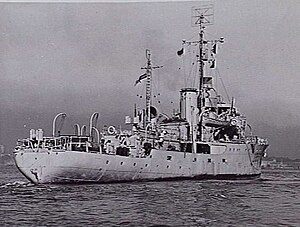HMAS Kiama

HMAS Kiama in 1944
|
|
| History | |
|---|---|
|
|
|
| Name: | HMAS Kiama |
| Namesake: | Town of Kiama, New South Wales |
| Builder: | Evans Deakin & Co |
| Laid down: | 2 November 1942 |
| Launched: | 3 July 1943 |
| Commissioned: | 26 January 1944 |
| Decommissioned: | 3 April 1946 |
| Identification: | Pennant number: J353 |
| Honours and awards: |
|
| Fate: | Transferred to RNZN |
|
|
|
| Acquired: | 5 March 1952 |
| Decommissioned: | 19 August 1976 |
| Renamed: | HMNZS Kiama |
| Reclassified: | Training ship |
| Identification: | Pennant number: M353 |
| Fate: | Paid off for disposal |
| General characteristics | |
| Class and type: | Bathurst-class corvette |
| Displacement: |
|
| Length: | 186 ft (57 m) |
| Beam: | 31 ft (9.4 m) |
| Draught: | 8.5 ft (2.6 m) |
| Installed power: | 2,000 hp (1,500 kW) |
| Propulsion: |
|
| Speed: | 15 knots (28 km/h; 17 mph) |
| Complement: |
|
| Armament: |
|
HMAS Kiama, named for the coastal town of Kiama, New South Wales, was one of 60 Bathurst-class corvettes constructed during World War II, and one of 36 initially manned and commissioned solely by the Royal Australian Navy (RAN).
After World War II, the corvette was one of four sold to the Royal New Zealand Navy (RNZN). She served as HMNZS Kiama from 1952 until 1976, when the corvette was paid off and marked for disposal.
In 1938, the Australian Commonwealth Naval Board (ACNB) identified the need for a general purpose 'local defence vessel' capable of both anti-submarine and mine-warfare duties, while easy to construct and operate. The vessel was initially envisaged as having a displacement of approximately 500 tons, a speed of at least 10 knots (19 km/h; 12 mph), and a range of 2,000 nautical miles (3,700 km; 2,300 mi) The opportunity to build a prototype in the place of a cancelled Bar-class boom defence vessel saw the proposed design increased to a 680-ton vessel, with a 15.5 knots (28.7 km/h; 17.8 mph) top speed, and a range of 2,850 nautical miles (5,280 km; 3,280 mi), armed with a 4-inch gun, equipped with asdic, and able to fitted with either depth charges or minesweeping equipment depending on the planned operations: although closer in size to a sloop than a local defence vessel, the resulting increased capabilities were accepted due to advantages over British-designed mine warfare and anti-submarine vessels. Construction of the prototype HMAS Kangaroo did not go ahead, but the plans were retained. The need for locally built 'all-rounder' vessels at the start of World War II saw the "Australian Minesweepers" (designated as such to hide their anti-submarine capability, but popularly referred to as "corvettes") approved in September 1939, with 60 constructed during the course of the war: 36 (including Kiama) ordered by the RAN, 20 ordered by the British Admiralty but manned and commissioned as RAN vessels, and 4 for the Royal Indian Navy.
...
Wikipedia
